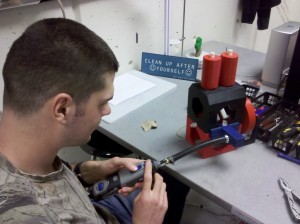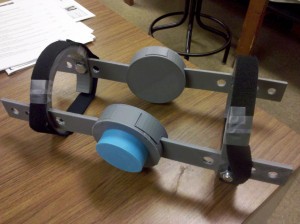 Students in the Tools for Engineering class teamed up to work on their final assignment, to build a working engine with specific requirements.
Students in the Tools for Engineering class teamed up to work on their final assignment, to build a working engine with specific requirements.
The 3D Lab was busy for a couple weeks with students designing and printing prototypes for their engines. All the groups came up with successful and unique designs.
While most engines were hand powered, some students designed engines to run using compressed air!
This success story also made news in the “Daily Record”.
 Students in the Tools for Engineering class teamed up to work on their final assignment, to build a working engine with specific requirements.
Students in the Tools for Engineering class teamed up to work on their final assignment, to build a working engine with specific requirements.
The 3D Lab was busy for a couple weeks with students designing and printing prototypes for their engines. All the groups came up with successful and unique designs.
While most engines were hand powered, some students designed engines to run using compressed air!
This success story also made news in the “Daily Record”.
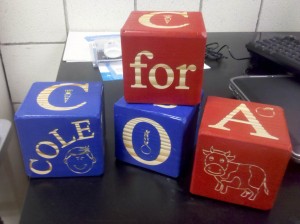 Students in the Tools for Engineering class teamed up to work on their final assignment, to build a working engine with specific requirements.
Students in the Tools for Engineering class teamed up to work on their final assignment, to build a working engine with specific requirements.
The 3D Lab was busy for a couple weeks with students designing and printing prototypes for their engines. All the groups came up with successful and unique designs.
While most engines were hand powered, some students designed engines to run using compressed air!
At the MAPS Air Museum, a Saber Jet with a damaged nose cone needed a cosmetic replacement. Our students used a 3D scanner
to scan the shape of a good nosecone on-site, then 3D print a replacement.
3D scanners are perfect for bringing shapes of physical objects into the computer, such as the motorcycle helmet below. This allows one to design enhancements for the helmet that will
fit perfectly.
RePlay for Kids repairs and adapts toys for children with disabilities. Their effort increases the number of functioning toys and assistive devices available for children with disabilities.
Our students dismantled a “touch light” to make it a “touch switch” instead, making it easy to activate and animate a stuffed animal. The switch’s modified baseplate and ring were 3D printed.
Students in the Tools for Engineering class build motors with moving parts, all created by 3D printers. These all-plastic motors were powered by hand, electrically, or pneumatically (air powered). Teams of two design their motors to compete with other teams for best design and performance.
It truly was a team effort! Each student had a different role in the process.
 The faucets in the Chemistry Lab use aerators to prevent fumes and algae buildup. However, the force generated causes water to splash outside the sink.
The faucets in the Chemistry Lab use aerators to prevent fumes and algae buildup. However, the force generated causes water to splash outside the sink.
Dusty (one of our engineering students) devised an adapter that slips inside the faucet’s flexible spout. This adapter redirects the water flow into a swirl, causing it to exit without pressure. This results in splash-less sinks at maximum water flow. Dusty’s design is completely original, created with 3D printing.
 3D printing is an experimental technology, fraught with trial and error. Failed prints result in wasted plastic. Instead of disposing in landfills, Will assembles a filament extruder. Feeding the extruder ground plastic or low-cost pellets, we are able to recycle plastic into fresh filament for more printing.
3D printing is an experimental technology, fraught with trial and error. Failed prints result in wasted plastic. Instead of disposing in landfills, Will assembles a filament extruder. Feeding the extruder ground plastic or low-cost pellets, we are able to recycle plastic into fresh filament for more printing.
Printing complex parts requires limonene in which unwanted plastic is dissolved away. Dusty created a technique to reclaim spent limonene into fresh solution again.
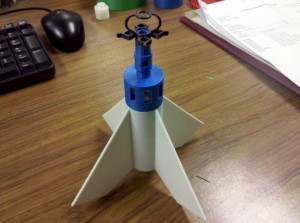 Engineering Student Jonnathan Martin (“Jonny”) used 3D printing technology to create an alternate model rocket descent system. Instead of the engine charge ejecting a parachute from the nosecone, it pushes a black plunger (above). This plunger opens the rocket body walls like pedals of a flower. The effect is the rocket “floating” to the ground.
Engineering Student Jonnathan Martin (“Jonny”) used 3D printing technology to create an alternate model rocket descent system. Instead of the engine charge ejecting a parachute from the nosecone, it pushes a black plunger (above). This plunger opens the rocket body walls like pedals of a flower. The effect is the rocket “floating” to the ground.
Jonny’s design illustrates complex parts that mechanically work together. Each part was individually printed on the 3D printers.
 Faculty, staff, and students bring broken plastic parts that are easily reproduced on the 3D printer. The replacement part is designed with CAD, printed, test fitted, and refined. Sometimes the new part is more durable than the original.
Faculty, staff, and students bring broken plastic parts that are easily reproduced on the 3D printer. The replacement part is designed with CAD, printed, test fitted, and refined. Sometimes the new part is more durable than the original.
With the addition of the 3D scanner, broken parts can be scanned and reproduced with minimal CAD involvement.
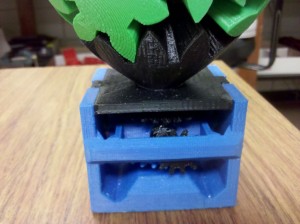 The original geared heart (above) was downloaded and printed from Thingiverse.com. While an overall good design, the hand crank was too weak and broke while turning the heart, gears would slip, etc.
The original geared heart (above) was downloaded and printed from Thingiverse.com. While an overall good design, the hand crank was too weak and broke while turning the heart, gears would slip, etc.
Engineering student Dusty improved the design by creating a stronger base, a new gearing system to reduce torque, and a new crank that is stronger and easier to turn. His ideas illustrate how ingenuity and creativity can improve an existing design.
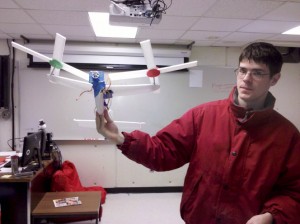 Members of the RC Flight Club build airplanes from foam board, motors, and 3D printed parts in the UAWC3 lab.
Members of the RC Flight Club build airplanes from foam board, motors, and 3D printed parts in the UAWC3 lab.
They design aircraft components using CAD then print them in ABS plastic such as engine mounts, landing gear, propellers, skis, and control horns.
Nathan built a model of a Fieseler Fi 156 Storch with a 5-foot wing span. This model can fly up to 400 feet and travel a mile in distance.
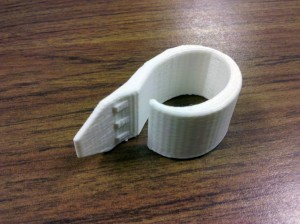 A student was born with a hand deformity in that he only has two fingers instead of five. This condition held him back from his dream of being able to play the guitar.
A student was born with a hand deformity in that he only has two fingers instead of five. This condition held him back from his dream of being able to play the guitar.
He talked to an engineering student about his passion for music. With a little bit of thought, Dusty came-up with a design for a guitar pick that, to everyone’s delight, fit the student’s hand perfectly.
This success story also made news in the “Daily Record”.
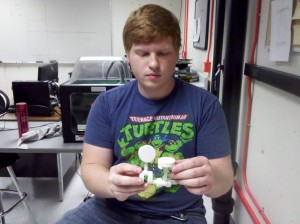 Students in the Tools for Engineering class teamed up to work on their final assignment, to build a working engine with specific requirements.
Students in the Tools for Engineering class teamed up to work on their final assignment, to build a working engine with specific requirements.
The 3D Lab was busy for a couple weeks with students designing and printing prototypes for their engines. All the groups came up with successful and unique designs.
While most engines were hand powered, some students designed engines to run using compressed air!
This success story also made news in the “Daily Record”.



